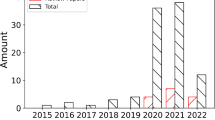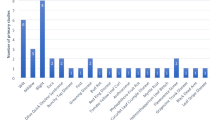Abstract
Computer-aided diagnosis and prognosis models have been used for management decisions in crop protection. Initial infection rate, temperature and leaf wetness are important parameters in disease epidemiology and for decision support models. So far, in-field variability and variability between fields have not been taken into account for management decisions in disease control. This study aimed at testing the use of an imaging IR thermography system as a tool for monitoring the microclimatic conditions promoting incidence and severity of diseases within wheat fields with a high spatial resolution. Experiments were conducted on the detection and differentiation of leaf wetness on a single leaf scale and a crop canopy scale (1 m2) under controlled conditions. Field studies focused on comparing ground-based and air-borne thermographic data and linking these to ground-truth data.











Similar content being viewed by others
References
DeVallavieille-Pope C, Huber L, Leconte M, Goyeau H (1995) Comparative effects of temperature and interrupted wet periods on germination, penetration and infection of Puccinia recondita f. sp. tritici and P. striiformis on wheat seedlings. Phytopathology 85(4):409–415
Derksen WJ (1974) Thermal infrared pictures and the mapping of microclimate. Netherland J Agric Sci 22:119–132
Duniway JM, Durbin RD (1971) Some effects of Uromyces phaseoli on the transpiration rate and stomatal response of bean leaves. Phytopathology 61:114–119
Everitt JH, Escobar DE, Appel DN, Riggs WG, Davis MR (1999) Using airborne digital imagery for detecting oak wilt disease. Plant Disease 83:502–505
Eversmeyer MG, Kramer CL, Hassan ZM (1988) Environmental influences on the establishment of Puccinia recondita infection structures. Plant Disease 71:409–412
Hatfield JL, Pinter PJ Jr, Chasseray E, Ezra CE, Reginato RJ, Idso SB, Jackson RD (1984) Effects of panicles on infrared thermometer measurements of canopy temperature in wheat. Agric Forest Meteorol 32:97–105
Jackson RD (1986) Remote sensing of biotic and abiotic plant stress. Annu Rev Phytopathol 24:265–287
Kluge E, Enzian S, Gutsche V (1999) Atlas der potentiellen Befallsgefährdung durch wichtige Schadorganismen im Ackerbau Deutschlands (Atlas of the Potential Risk of Important Pathogenic Organisms in German Agriculture). Biologische Bundesanstalt für Land- u. Forstwirtschaft, Berlin und Braunschweig ISBN 3-930037-01-7
Lovell DJ, Hunter T, Powers SJ, Parker SR, Van den Bosch F (2004) Effect of temperature on latent period of Septoria leaf blotch on winter wheat under outdoor conditions. Plant Pathol 53:170–181
Luquet D, Vidal A, Dauzat J, Clouvel P (2003) 3D simulation of directional temperature variability within a row-cotton crop: toward an improvement of experimental crop water status monitoring using thermal infrared. Precision Agric 4:297–309
Pinter PJ Jr (1986) Effect of dew on canopy reflectance and temperature. Remote Sensing Environ 19:187–205
Rashid A, Stark JC, Tanveer A, Mustafa T (1999) Use of canopy temperature measurements as a screening tool for drought tolerance in spring wheat. J Agron Crop Sci 182:231–237
Schuster N, Kolobrodov V (2000) Infrarotthermographie (Infrared thermography). Wiley-VCH, Berlin, Germany
Smith RCG, Heritage AD, Stapper M, Barrs HD (1986) Effect of stripe rust (Puccinia striiformis West.) and irrigation on the yield of foliage temperature of wheat. Field Crops Res 14:39–51
Tottman DR, Broad H (1987) The decimal code for the growth stages of cereals, with illustrations. Ann Rev Appl Biol 110:441–454
Watson WT, Kenerley CM, Appel DN (2000) Visual and infrared assessment of root colonization of apple trees by Phymatotrichopsis omnivora. Plant Disease 84:540–543
Acknowledgements
This project is part of a graduate research and training program funded by DFG (Deutsche Forschungsgemeinschaft). We thank InfraTec GmbH, Dresden for their technical support.
Author information
Authors and Affiliations
Corresponding author
Rights and permissions
About this article
Cite this article
Lenthe, JH., Oerke, EC. & Dehne, HW. Digital infrared thermography for monitoring canopy health of wheat. Precision Agric 8, 15–26 (2007). https://doi.org/10.1007/s11119-006-9025-6
Published:
Issue Date:
DOI: https://doi.org/10.1007/s11119-006-9025-6




